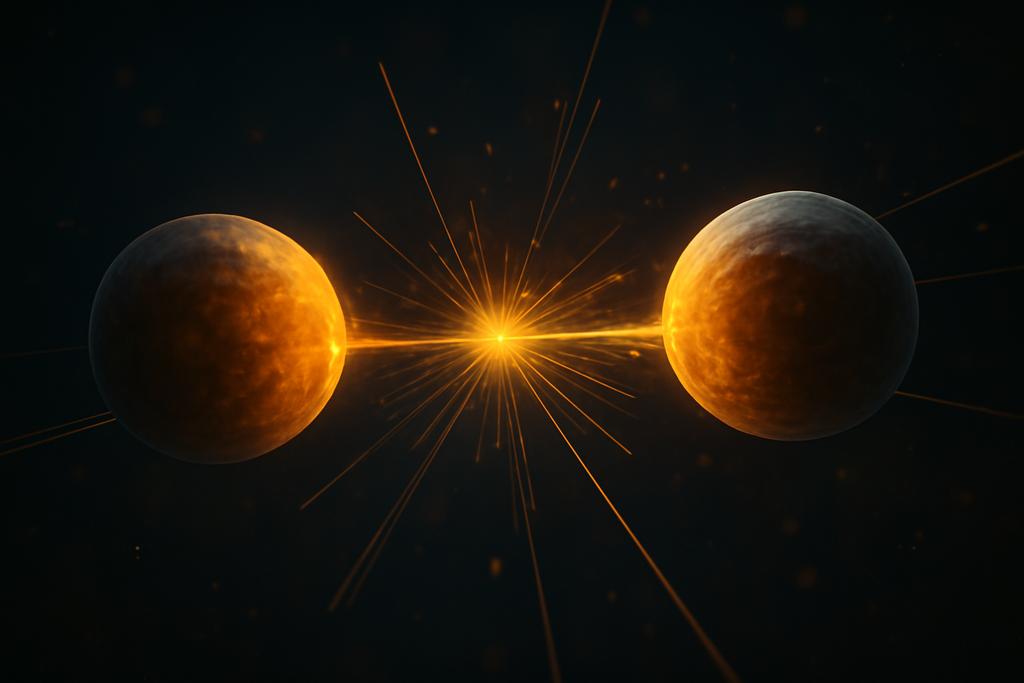Imagine a collision so minuscule, it involves just two electrons. But within that seemingly insignificant event lies a potential revolution in our understanding of fundamental physics. A new study from researchers at the PSI Center for Neutron and Muon Sciences and the Physik-Institut, Universität Zürich, delves into the subtle world of parity violation in Møller scattering—the scattering of two electrons—at low energies. This research, led by Sophie Kollatzsch, Daniel Moreno, David Radic, and Adrian Signer, offers a highly precise theoretical framework to analyze these interactions, potentially resolving long-standing tensions in the Standard Model of particle physics.
The Mysterious Parity Violation
At the heart of this work lies the concept of parity violation. In simpler terms, this refers to the asymmetry between left and right in the fundamental forces of nature. Some forces, like electromagnetism, treat left and right equally, while others, like the weak nuclear force, don’t. This difference was a pivotal discovery in physics, leading to the development of the electroweak sector of the Standard Model, which unifies electromagnetism and the weak force. The weak mixing angle, denoted as sW, is a crucial parameter within this theory, representing the blend of these two forces.
While the Standard Model is remarkably successful in describing particle interactions, there are subtle inconsistencies, notably a slight tension between high-energy measurements of sW and those at low energies. This discrepancy has fueled speculation about new physics beyond the Standard Model—particles or forces we haven’t yet discovered. Precise measurements of parity violation at low energies offer a sensitive probe to detect these potential anomalies.
Precision at the Frontier
The MOLLER experiment at the Thomas Jefferson National Accelerator Facility (JLab) aims to measure the parity-violating asymmetry in Møller scattering with unprecedented accuracy—a precision of 2-3%. This level of precision requires similarly precise theoretical predictions. The researchers’ innovative approach utilizes low-energy effective field theory (LEFT). This theoretical framework allows them to systematically account for the differences in energy scales involved in the interaction, integrating out the heavier particles of the electroweak scale and focusing on the crucial low-energy details.
The power of LEFT lies in its ability to resum large logarithms—mathematical terms that emerge when comparing widely different energy scales. These logarithms can significantly affect calculations, making them less precise. By effectively summing them, LEFT provides a more robust and accurate theoretical basis for interpreting experimental results.
Beyond the Standard Approach
The researchers’ method differs from previous calculations. Instead of relying on a direct calculation within the full Standard Model, they employ the elegant framework of LEFT. This approach provides several advantages. First, it simplifies the calculation by focusing only on relevant low-energy effects. Second, it systematically accounts for the large logarithms that plague previous calculations. And finally, LEFT provides a cleaner, more systematic way to investigate effects beyond the Standard Model that could show up as tiny deviations from the predicted asymmetry.
The authors also highlight the crucial role of real corrections—those accounting for the emission of photons—in achieving results that directly compare to the experimental data. The inclusion of such corrections, and particularly the combination of QED (quantum electrodynamics) and EW (electroweak) corrections, is essential for accurate predictions. Neglecting these can lead to sizable discrepancies, demonstrating the importance of their comprehensive approach.
The Implications
This research doesn’t just refine our theoretical understanding of a specific process. It strengthens our tools for exploring fundamental physics. The improved precision offered by LEFT, combined with the experimental precision of MOLLER, could reveal tiny inconsistencies with the Standard Model, hinting at a larger picture yet to be understood. The implications are profound. This could lead to new discoveries and a deeper understanding of the universe’s most fundamental building blocks.
The authors’ work goes beyond theoretical calculations; they have also implemented their results into a publicly available Monte Carlo framework, McMule. This makes their work directly accessible to the experimental community, facilitating a smoother comparison between theory and experiment and accelerating future research. This collaborative approach highlights the importance of open-source tools in advancing scientific discovery.
Ultimately, this seemingly small study holds the potential to significantly impact our understanding of fundamental physics. It provides a powerful methodology to tackle complex calculations and paves the way for deeper explorations into the still-mysterious realm of parity violation and physics beyond the Standard Model.










